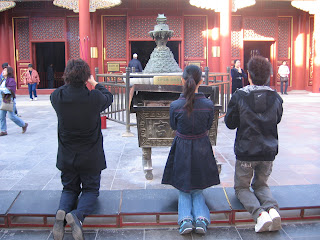
"How do we get from the airport to our hotel? What's the fastest and cheapest way?" I asked the airport customer service lady in as best of Mandarin as I could muster.
"Airport taxi. 300 yuan," she said, giving her male colleague a coy smirk. It was this smirk that did not sit right with us, so we decided to find a different way. We ended up taking the public transit to our hotel for only 54 yuan - and ended up getting quite the adventure and instant immersion into Beijing life as a result.
It was interesting navigating through rush hour. You think Toronto rush hour on the subway is bad? Try doubling the crowds, not knowing where the hell you're going, constantly asking for directions in broken Mandarin (and hoping you're saying what you intend to say and not something culturally offensive) and having everyone snicker at your really gay blue floral-patterned suitcases (although in fairness to Andrew, they are so easy to spot right away on the baggage claim). Not to mention, you feel like you've stepped inside Pacific Mall everywhere you turn.
I'm a public transit advocate by heart - and often derive my first impressions of a location by the quality of its public transit. While the crowds were absolutely nauseating - esp. when you're feeling self-conscious about last showering almost 2 days ago - I was quite impressed by some of the things I observed.
The thing I was most impressed by was the direct subway access to the airport. The train cars (see photo below) on this line of three stops were immaculately clean. LCD screens playing the news, above-head storage, next-train arrival estimation on the platform, on-train security cameras, and automated announcements in both Mandarin and English were just some of the great user-centred features.

The rest of the system is more similar to NYC's labyrinth of multiple lines, rather than Toronto's. I was impressed - and thankful - that directional signs were both in Chinese and English. It was interesting seeing military officers patrolling the system. It was also really cool to see different forms of transit advertising - for instance, on the concrete walls between some of the station stops, ads came to life when your train whizzed by; think of static images placed side by side that work like animation.
Toronto's TTC system - under the capable leadership of Adam Giambrone - has been trying to do some of these things (most recently piloting next-train arrival estimation at Dundas Station). I think we have a ways to catch up still - although I'm confident we will - but it was inspiring to see what was possible.
I'm in love with what I've seen of Beijing so far - although I admit I was extremely sleep-deprived as we found our way to our hotel earlier, so seeing a hot dog stand would've blown me away. But I'm looking forward to discovering the rest of the city - starting with my first late-night run to a real Chinese restaurant, as soon as I'm able to drag Andrew up from his nap.







































